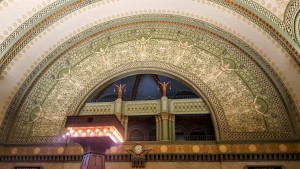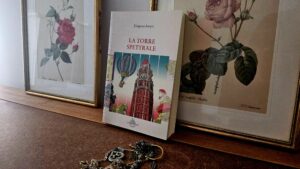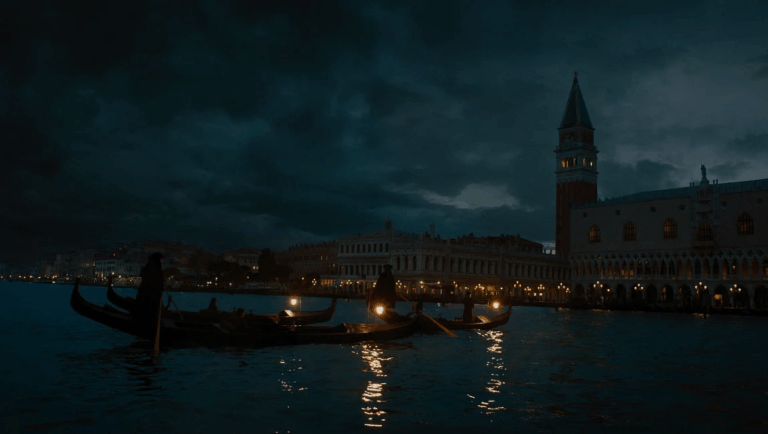I didn’t have time to roam around too much, giving we were buried alive in a conference, but a member of the committee took his time to show us around a little bit the day before, so I do have a couple of considerations regarding the city.
First of all, it’s hot. Like you have no idea. Hot and humid, worst than Singapore, although this time I didn’t feel sick and that’s a plus.
The city, they told me, was designed to be something grand, like a New York: they have broad roads, a lot wider than some highways in Italy, and a lot of backup space for further expansions, in the form of an equally broad strip of green between the roads and the buildings. It’s not a bad plan. Only, it didn’t work. The city didn’t attract people and, on the contrary, people moved away. Apparently, they’re now called “Flyover States”, states that are only good to fly over with a plane in order to go elsewhere.
The result is an eerie sensation, at least for an European such as myself. It looks like something happened. Something sudden and bad. Like a zombie apocalypse. Big empty roads, in broad daylight, with no one to drive through and only a couple of cars parked nearby. Very few people walking too: nobody is staying in the parks, hence turning to no places and adding to that strange feeling.
That being said, they have some beautiful architecture. And if you’re not into buildings, you might skip this post entirely because this is going to be about that.
1. The Union Station Hotel
Chosen as the venue for the event we were attending, it’s a beautiful place and if you’re lucky enough to stay there I strongly recommend you try and book a tour with the lady at the reservation desk. She’s been working there for decades and researches the place out of passion. Equally out of passion, as a side job, she offers tours of the building and will take you to see places you wouldn’t normally see, like under the roof, inside the vault and in the clock tower.
As the name might suggest to the brightest lads, the place was a train station and what a train station must have been! The overall complex was designed by Theodore Link with Edward Cameron, allegedly taking inspiration from the fortifications of Carcassonne (I’ve been both places and I don’t see it, but ok): it’s the same buy who did the Mississipi State Capitol, but expect a very different style. The train shed is huge and was designed by engineer George H. Pengram, who specialized in truss bridges.
Like many other buildings in St Louis, it’s not old as it seems: it was firstly opened in 1894 and expanded in 1903 to prepare for the Louisiana Purchase Exposition. I know. St Louis is not in Louisiana but you know, Americans, they like to confuse us like with the State of Washington and Washington D.C., or like with New York and the State of New York. Anyway, enter airplanes and the station becomes obsolete. In 1970 it was declared a National Historic Landmark and in 1985 HoK designed a $150 million project to convert it into a hotel. It was furtherly renovated in 2010, when Marriott stepped down as the operator, they stripped it of the retail section and added a Memories Museum. They’re currently working on a 75,000 sqf Aquarium: you can see it on your left if you look out from the swimming pool. It’s supposed to be open in 2018 but I don’t see it happening: maybe next year.
The first thing you must see is the first thing you will see: the main hall. It’s a stunning place where every evening they use the 20m barrel-vaulted ceiling as a canvas to project light shows. The Aquarium one at midnight is stunning.
Grab a drink at the bar, sit down to enjoy the place, look up and then see if you can reach level 2: the balcony you see from behind, with the two ladies holding lanterns, is accessible and offers an even more stunning view of the place.
While you’re up there, take a stroll down the corridor. There, the old agent’s offices were converted into rooms and they tried to preserve as much as they could. You’ll see a recreation of the original doors, even if the lady told us that the names are not accurate, and some canvas printed with the old routes and fares.
If you were lucky enough and could steal the lady at the reservation desk for a tour, she’ll take you up where no man has gone before: under the roof. They’re currently working, there, and for someone such as myself… well, it’s a playground. The flavor of the place is really similar to the hotel I did in Amsterdam with Piero Lissoni. Only something didn’t smell right. After a while I was able to bring it into focus: what’s usually made of wood, here is made of steel. Steel trusses, to be exact. Which is weird. Weirder still, apparently the brick walls are made of concrete poured into the bricks, used as forms. That’s not how we do it, baby.
Anyway, seen from above, the structure of the dome is fantastic (it’s fantastic that it stands, actually) and you’ll see why it’s so freezing down there: those, sir, are some big ducts indeed. The clock tower is also something to behold: 85m of grandeur with an inner staircase you can climb, up until a certain point at least. The structure here is equally amazing. And, if you’re there, try and sneak inside the vault.
On the other hand, if you’re claustrophobic or simply couldn’t catch the lady you can drop by the swimming pool and the back yard, by the covered patio between the two branches of the hotel. You have some actual trains, back there, a coupe of places to grab a bite (the fish wasn’t bad, actually).
You can play with your kids and annoy everybody else, or you can wait for the show. I wasn’t expecting it, because I don’t read signs, so I was chilling in the pool the day before the conference, waiting for my business partner to deal with some technical shit, and… well, this happened.
2. Down by Market Street
2.1 The U.S. Postal Service Building
If you go down by Market Street (yes, this was Market Street as well) the first building to strike you in the face will be the U.S. Postal Service, to your right. And mind that this is not the big one: the big one, the landmark, is the one in Olive Street. I have to thank the research of this Steve Patterson guy, because it was really difficult to find out anything at all about this place. Apparently (thank you Steve), its history is a bit controversial: though a plaque says it was finished in 1935 and designed by those same Klipstein & Rathmann responsible for putting a Greek temple at the top of a skyscraper (the Civil Courts Building, but more on that later) and the Bevo Bottling Facility, in the core years of the prohibition. That took guts.

I know, the picture is not straight and no, that’s not my kid. Let us all try and not freak out because there’s a random unknown kid in the picture, ok?
2.2 Strifel Theatre
If you keep walking down the street, the next building is the Strifel Theater, a.k.a. the Kiel Opera House, also from 1934. It was designed by Louis LaBeaume and Eugene S. Klein, mostly known for their works in luxury private buildings around the city. The inspiration from the design is explained if you bother to take a look into the City Beautiful movement, a philosophy of aesthetics that took place between 1890 and 1900 among North Americans architects and urban planners. Their aim was to introduce beauty and monumental grandeur in the cities and their belief was that, by merely introducing grand beautiful buildings, the quality of life could increase by introducing a harmonious social order of Socialist imprint. And if their buildings look fascist to you, don’t be surprised and remember that those guys professed to be socialists as well, at least at the beginning. We all know that the ideas of such movement didn’t quite work out: their detractors point out that those architects seemed to be mostly interested in monuments rather than the social impact of their buildings on the city. By looking at St Louis today, you have to admit that it’s a fair criticism.
The facade of the building has a couple of quotes by Woodrow Wilson, XXVIII President of the United States between 1913 and 1921, and Carl Schurz, prominent republican and refugees in the U.S. after the German revolutions of 1848–49 in which he took active part.
Simple means should be found by which, by an interchange of points of view we may get together, for the whole process of modern life is a process by which we must exclude misunderstanding, bring all men into common counsel, and so discover what is the common interest.
— Woodrow WilsonDemocratic Government will be the more successful the more the Public Opinion ruling is enlightened and inspired by full and thorough discussion… The greatest danger threatening democratic institutions comes from those influences which tend to stifle or demoralize discussion.
— Carl Schurz
Two huge bears in limestone are crouching by the entrance, guarding it. Apparently they are the Missouri bears. Wasn’t that the California bear? Well, apparently that’s an entirely different kind of bear. Same goes for the lone star of California, which is very different from the lone star of Texas and… yeah, as I told you, they like to confuse us.
2.3 City Hall
Keep walking towards the Arch (you only covered two blocks, you can’t be tired yet) and you will find the astonishing City Hall. Finally something that doesn’t seem to pop out from The Dystopian Guide for Architects.
It’s a tad older than the other ones: it was built between 1892 and 1904 from a design by Eckel and Mann in full Renaissance Revival. In case you’re not familiar with the movement, it’s a really fun one, especially if you’re Italian. Instead of taking inspiration from the Classical architecture or from the Gothic one, the movement intends to draw inspiration from the Italian Renaissance, which is fun because Renaissance itself drew inspiration from the Classical architecture, so where’s the line? Truth is, Neo-Renaissance takes inspiration from Italy just as much as France, England and Russia.
This particular building was supposedly inspired by the Hotel de Ville in Paris, especially for its composition. The first story is in pink granite, the upper ones are in sandstone and yellow bricks. The red roof with the round windows is delicious. Not that I’ve tasted it, but I can totally see it baked into a cake.
2.4 Carnahan Courthouse
Keep walking, and literally in the next block you’ll have another really ugly 1930 thing in your face. It’s the Carnahan Courthouse, named after the Democratic governor Mel Carnahan, built in 1935 by Mauran, Russell & Crowell. That must have been a busy year on Market Street. John Mauran alone was responsible for lots of buildings in the city like the Railway Exchange Building, the famous Wainwright Building (a beautiful building in terracotta commonly known to be the first highrise) and the Soldier’s Memorial right across the street. The Courthouse is more similar to the latter, in style, and when I say style I mean in having huge pointless square columns and eagles in corners.
2.5 Civil Courts Building
Right across the street, a slightly more interesting building is the Civil Courts, where the 22nd Judicial Circuit Court is instated now.
For some weird reason, the facade has 13m height 32 Ionic columns in Indiana limestone, the roof is shaped after the Mausoleum at Halicarnassus (I’m pretty sure it didn’t have that shape) and on top of the roof you can see (with a binocular) two sphinxes of 3.7m height, sculpted by Steven A. Rebeck.
The sphinx-like ornaments are aluminum shells, each 20 feet long and 11½ feet high. The interior of each resembles a room of ordinary size, to which access is gained through an opening at the base. Reclining back to back, one of the figures faces east and the other west. Encrusted on the breast of each is the fleur-de-lis of St. Louis. The griffins, with the aluminum of the roof, form a huge lightning conductor, which is connected with the grouch by concealed wires.
— St Louis Times
3. The City Museum
One thing you must do if you’re in town is going to the City Museum. Now, you know I love museum and I annoyed you long enough with the ones I saw in San Francisco, but I promise this one is different. There are a couple of exhibits, here and there, but that’s far from being the point. Aside from traditional exhibits, you’ll find industrial and architectural objects, re-purposed to be slides and stairs you can climb on. All the place is literally one huge amusement park for both kids and grown ups: you can crawl your way up and see more stuff to crawl your way into, or simply take the train, go up and slide your way down. All the way down.






































No Comments